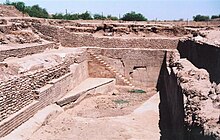


This map shows cities, towns, and other sites of the ancient Indus Valley civilization. It also shows the borders of the modern countries of Pakistan and India, as well as some modern cities and regions.
Encyclopædia Britannica, Inc.

Between 400 and as many as 600 distinct Indus symbols have been found on seals, small tablets, ceramic pots and more than a dozen other materials, including a "signboard" that apparently once hung over the gate of the inner citadel of the Indus city of Dholavira.
Ten Indus Signs, dubbed Dholavira Signboard
Typical Indus inscriptions are no more than four or five characters in length, most of which are tiny; the longest on a single surface, which is less than 1 inch (2.54 cm) square, is 17 signs long; the longest on any object (found on three different faces of a mass-produced object) has a length of 26 symbols.
In a 2009 study by P. N. Rao et al. published in Science, computer scientists, comparing the pattern of symbols to various linguistic scripts and non-linguistic systems, including DNA and a computer programming language, found that the Indus script's pattern is closer to that of spoken words.
The messages on the seals are too short to be decoded by a computer.
Sourse: https://kids.kiddle.co/Indus_Valley_civilization#Writing_system
c. 7000 BCE
Evidence of religious practices in the Indus Valley.c. 7000 BCE - c. 600 BCE
The Indus Valley (or Harappan) Civilization.c. 4000 BCE
Farming settlements are established in the Indus Valley.c. 3000 BCE
First signs of urbanization in the Indus Valley.c. 3000 BCE
The Aryans - nomadic northerners from central Asia - possibly begin to migrate into the Indus Valley in an early phase of migration.c. 2800 BCE - c. 1900 BCE
The rise of the great Indian cities of Mohenjo Daro and Harappa.c. 2600 BCE
Hundreds of towns and cities are established throughout the Indus Valley.c. 2500 BCE
Earliest use of the Indus Script.c. 2000 BCE - c. 1500 BCE
The Aryans expand into the Ganges valley in India.530 BCE
Persia conquers the Indus Valley.
For the full lesson, click HERE.